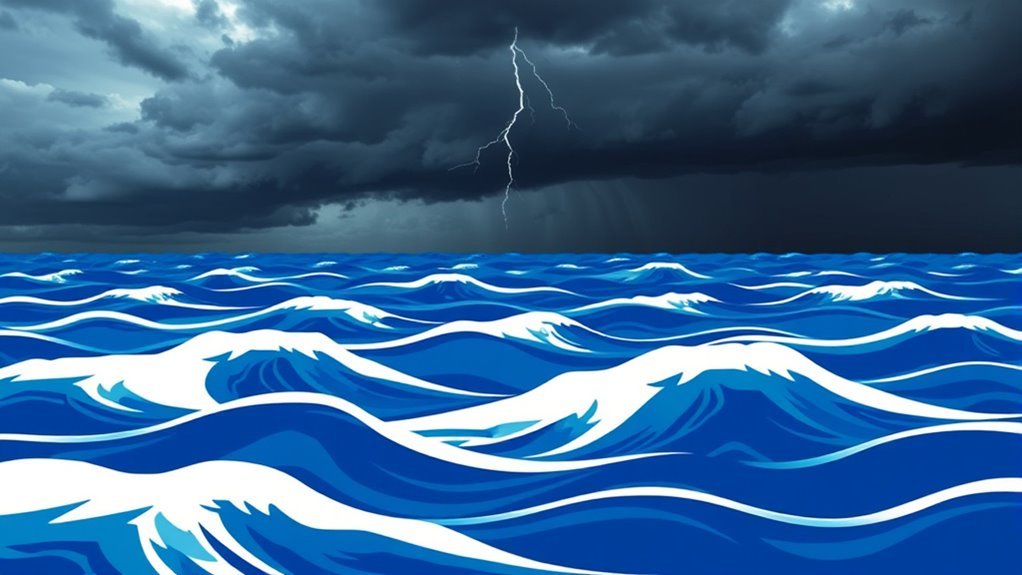Over the decades, notable discoveries in squall research include early observations that identified characteristics and connections to weather systems. The advent of Doppler radar revolutionized squall detection and forecasting accuracy. Studies on squall dynamics revealed the role of atmospheric conditions in formation. Climate change consequences on squall frequency and intensity are increasingly acknowledged. These findings not only inform agricultural and maritime safety but also lay the groundwork for future advancements in squall research and technology.
Main Points
- Pioneering studies in the late 19th and early 20th centuries established foundational knowledge of squall characteristics and their connections to larger weather systems.
- The advent of Doppler radar revolutionized squall detection and prediction, providing real-time data on wind patterns and precipitation.
- Research on squall line dynamics revealed the role of warm, moist air convergence and wind shear in storm formation and longevity.
- Climate change studies indicate rising temperatures may increase squall frequency and intensity due to enhanced moisture retention in the atmosphere.
- Recent advancements in technology, including machine learning and drones, promise improved forecasting and public awareness tools for squall preparedness.
The Early Observations of Squalls: Pioneering Studies
Although squalls have long been a subject of fascination for meteorologists, it was during the late 19th and early 20th centuries that pioneering studies began to illuminate their characteristics and behavior.
Early meteorologists, through a combination of field observations and rudimentary instruments, sought to understand the dynamics of these sudden, intense weather events. Notable studies focused on the rapid changes in wind direction and speed, as well as the accompanying precipitation patterns.
Researchers like William Ferrel and others documented the connections between squalls and larger weather systems, emphasizing their role in severe weather. Their meticulous observations laid the groundwork for future research, establishing a foundation for understanding the complexities of squall formation and movement.
This era marked a noteworthy shift in meteorological science, as it moved towards a more systematic approach, enabling subsequent generations of scientists to build upon these early findings to further disclose the intricacies of squall phenomena.
The Role of Doppler Radar in Squall Detection

Doppler radar technology has revolutionized the detection and analysis of squalls by providing real-time data on wind patterns and precipitation.
Its augmented capabilities allow for improved forecasting and response strategies, which are critical in mitigating the impacts of these severe weather events.
Case studies demonstrate the effectiveness of Doppler radar in identifying squall formations and their evolution.
Doppler Radar Basics
As meteorologists endeavor to improve squall detection, understanding the fundamentals of Doppler radar becomes vital. This technology utilizes the Doppler effect to measure the frequency change of radar waves reflected off moving precipitation particles.
By emitting pulses of microwave energy and analyzing the returned signals, Doppler radar identifies not only the location and intensity of precipitation but also its movement, such as speed and direction. This capability allows for the real-time monitoring of storm systems, helping to detect squalls as they develop.
The information gathered by Doppler radar can be significant for issuing timely warnings and improving safety for those in affected areas. In the end, the integration of Doppler radar into squall research improves the understanding of these complex weather phenomena.
Enhanced Detection Capabilities
While traditional weather forecasting methods have their merits, the improved detection capabilities of modern Doppler radar systems greatly increase squall detection accuracy.
These advanced systems utilize the Doppler effect to measure the velocity of precipitation, allowing meteorologists to identify wind shear and rotation within squall lines more effectively.
Additionally, Doppler radar can detect precipitation intensity and movement patterns, providing critical real-time data that augments situational awareness.
The ability to generate three-dimensional images of storm structures further aids in predicting the development and intensity of squalls.
Consequently, the integration of Doppler radar into meteorological practices has transformed squall detection, enabling timely warnings and potentially reducing the risks associated with severe weather events.
Case Studies in Squall
Recent advancements in Doppler radar technology have greatly improved the understanding of squall dynamics through various case studies. These investigations have revealed critical information regarding the formation, intensity, and movement of squalls.
For instance, a notable case study in the Midwest demonstrated how Doppler radar successfully tracked the rapid development of a squall line, providing real-time data on wind shear and precipitation patterns. This data enabled meteorologists to issue timely warnings, greatly enhancing public safety.
Additionally, studies in coastal regions utilized Doppler radar to analyze the interactions between squalls and marine environments, leading to improved forecasting models.
Altogether, these case studies underscore the essential role of Doppler radar in advancing knowledge of squall behavior and enhancing predictive capabilities.
Understanding the Dynamics of Squall Lines

Understanding the dynamics of squall lines involves examining their formation mechanisms and the subsequent impacts on weather patterns.
These complex systems arise from various atmospheric conditions that contribute to their development and intensity.
Formation Mechanisms Explained
Squall lines, defined by their intense thunderstorms and strong winds, form through a complex interplay of atmospheric conditions.
The primary mechanism involves the convergence of warm, moist air at the surface, which rises and cools, leading to condensation and storm development. This process is often improved by the presence of a cold front or boundary, which forces the warm air upward.
Additionally, wind shear—variations in wind speed and direction with height—can contribute to the organization and longevity of squall lines.
The interaction between these factors creates well-defined lines of convection, capable of producing severe weather phenomena.
Understanding these formation mechanisms is essential for improving forecasting and mitigating the impacts of squall lines on affected regions.
Impacts on Weather Patterns
The formation mechanisms of squall lines markedly influence local and regional weather patterns. These intense weather events are defined by a rapid shift from calm conditions to severe storms, often accompanied by heavy rainfall, strong winds, and occasional hail. Their development can lead to notable temperature changes, altering thermal profiles in affected areas.
Moreover, squall lines can cause abrupt shifts in humidity levels, impacting agricultural practices and water resources. Their interaction with prevailing winds may also influence the trajectory and intensity of subsequent weather systems.
Understanding these dynamics is essential for meteorologists, as squall lines can trigger flash flooding and severe weather warnings, thereby enhancing public safety and preparedness in vulnerable regions.
Advances in Numerical Weather Prediction Models

As advancements in computational technology continue to evolve, numerical weather prediction models have greatly improved in accuracy and reliability. These models utilize complex algorithms and high-resolution data to simulate atmospheric conditions, enabling meteorologists to predict squall formations with greater precision.
Improved satellite observations and ground-based radar systems have further enriched the datasets used in these models, providing real-time revelations into weather phenomena.
Recent developments in machine learning and artificial intelligence also contribute notably to model performance. By analyzing extensive amounts of historical weather data, these technologies can identify patterns and improve forecasting techniques.
Additionally, ensemble forecasting approaches, which combine multiple model outputs, bolster the robustness of predictions related to squall events.
The integration of these advancements not only aids in better understanding squall dynamics but also promotes timely warnings for affected regions, ultimately enhancing public safety and preparedness against severe weather conditions.
The Impact of Climate Change on Squall Patterns

While researchers continue to investigate the nuances of weather patterns, the influence of climate change on squall formations has become increasingly evident. Rising global temperatures have led to alterations in atmospheric conditions, which in turn affect the frequency and intensity of squalls. Studies indicate that warmer air holds more moisture, potentially resulting in more severe squall events.
In addition, changes in wind patterns, driven by climate change, can modify the dynamics of squall development, impacting their trajectories and duration.
Additionally, the interaction between squalls and other meteorological phenomena has become more complex. Increased variability in ocean temperatures may also contribute to more unpredictable squall patterns.
The consequences of these changes extend beyond meteorology, as they pose challenges for various sectors, including agriculture and transportation. Understanding how climate change shapes squall behavior is essential for developing flexible strategies and mitigating potential risks associated with these intense weather events.
Squall Research and Its Influence on Maritime Safety
Understanding squall behavior is essential for improving maritime safety, particularly given the unpredictable nature of these intense weather events. Recent research has focused on the identification and forecasting of squalls, leading to improved warning systems that can alert mariners to sudden changes in weather conditions.
The development of sophisticated meteorological models has enabled researchers to better predict squall formation and track their paths, allowing for timely responses from vessels at sea.
Furthermore, enhanced data collection methods, such as satellite imagery and buoy monitoring, have contributed to a more thorough understanding of squall dynamics. This information aids in the creation of educational programs for sailors, emphasizing the importance of situational awareness and preparedness.
In the end, the ongoing research in this field plays a significant role in minimizing the risks associated with squalls, thereby safeguarding lives and property in maritime operations. Such advancements underscore the essential intersection of scientific inquiry and practical maritime safety measures.
The Future of Squall Research: Emerging Technologies and Trends
With advancements in technology shaping the environment of meteorological research, the future of squall studies holds tremendous promise. Emerging technologies are set to revolutionize how scientists understand and predict these fierce storms, improving safety for maritime activities and beyond.
- Drones: Equipped with sensors, drones can collect real-time data in squall-prone areas, offering revelations previously unattainable.
- Machine Learning: Algorithms can analyze extensive datasets to identify patterns and improve predictive models, increasing forecasting accuracy.
- Remote Sensing: Satellite technology allows for continuous monitoring of atmospheric conditions, providing essential information on squall formation.
- Public Awareness Tools: Cutting-edge mobile applications can deliver timely alerts to communities, ensuring preparedness and reducing risks associated with squalls.
These advancements signify a transformative era in squall research, promising to save lives and protect property through improved understanding and preparedness.
The integration of technology into meteorological studies will certainly pave the way for a safer future.
Common Questions
What Are Squalls and How Do They Form?
Squalls are sudden, intense bursts of wind and rain, typically associated with thunderstorms. They form when warm, moist air rises rapidly, creating turbulent conditions that lead to brief, severe weather events, often catching observers off guard.
How Do Squalls Differ From Thunderstorms?
Squalls differ from thunderstorms primarily in duration and intensity. Squalls are brief, intense wind events often accompanied by rain, while thunderstorms are defined by prolonged precipitation, lightning, and thunder, with potentially severe weather effects.
Can Squalls Occur in Winter?
Squalls can indeed occur in winter, though they are less common than in warmer months. These winter squalls typically bring brief, intense snowfall and strong winds, creating hazardous conditions for travelers and outdoor activities.
What Safety Measures Should Be Taken During a Squall?
When a squall occurs, individuals should seek shelter indoors, avoid driving if possible, secure loose objects outdoors, and stay informed through weather updates. Preparedness and caution are essential to guarantee safety during such sudden weather events.
How Do Squalls Affect Local Ecosystems?
Squalls greatly impact local ecosystems by altering temperature and humidity levels, promoting rapid changes in vegetation and animal behavior. These weather events can lead to increased nutrient runoff, affecting water quality and biodiversity in affected areas.

